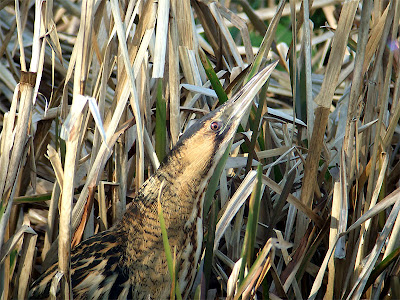Britain’s booming bird on the increase
The bittern – a shy heron that was formerly extinct in Britain – has enjoyed its best nesting season for at least 130 years, according to an RSPB and Natural England survey.
Surveyors, listening for the male bittern’s distinctive ‘booming’ song, recorded 75 male bitterns in English reedbeds, an increase of 47 per cent on 2007’s figures and a staggering 581 per cent increase in the numbers recorded in 1997, when the UK population plummeted to a recent low of just 11 booming males, all in England. The number of English counties hosting booming bitterns has also increased to 10, rising from eight in 2007 and four in 1997.
Dr Mark Avery, the RSPB’s conservation director, said: “The bittern has suffered an ill-fated history in the UK, having endured extinction once and having been on the verge of extinction again in the late 1990s.”
Although currently confined to England, the bittern was formerly widespread across the UK, where it has endured a boom-and-bust history. In 1886, the bittern stopped nesting in the UK, after drainage of wetlands, and persecution pushed the bird to extinction. Bitterns recolonised the UK in 1911, when birds were found breeding again in the Norfolk Broads.
Dr Mark Avery added: “We weren’t prepared to accept a second extinction of the bittern, so we launched a rescue bid to keep the bittern as a British bird. This bid has been so successful that a wide range of other wildlife has benefited too. There are too many threatened species in the world and the turning around of the UK’s bittern population shows what can be achieved with a combination of practical determination, proper research and appropriate funding.”
Researchers believe this year’s bumper population is directly linked to the very wet winter, which provided ideal feeding conditions for female bitterns, allowing them to get into breeding condition. Overall, the bittern population is increasing because of large-scale recreation and management of reedbeds.
Dr Pete Brotherton, Head of Biodiversity for Natural England, said: “This year’s figures are a fantastic achievement and show that we can bring species back from the brink of extinction. You would probably have to go back at least 130 years to find a better year for this booming bird.”
Part of this bittern rescue package focused on identifying the reasons behind the bird’s decline. Research showed that the bittern’s future in the UK is entirely dependent on continued efforts to manage and recreate reedbeds – the bird’s principle watery habitat.
“Despite our success, there’s still much more to do. We are working to halt the loss and fragmentation of the country’s wetlands and to create new ones,” continued Dr Brotherton. “We know bitterns can thrive on coastal and inland freshwater wetlands, and we are confident that we can extend its range still further so that more people can enjoy its distinctive booming call.”
Joan Ruddock, Minister for Wildlife, said: “It is vitally important that we conserve our rich variety of wildlife such as the bittern and that is why the Government works with conservation groups like the RSPB on these projects. This year’s wet weather has helped the bittern population which shows the real impact of small changes in our climate. Understanding the impact of these changes is key to conserving our wildlife, and taking forward effective management of habitats.”
One of the key concerns with the UK’s bittern population in the 1990s was that reedbeds were drying out, preventing the bird from finding enough food. Two massive projects involving funding from the European Union’s Life Fund has helped to restore or recreate reedbed sites making them more suitable for bitterns.
 East Anglia is still the stronghold of the UK bittern population. But, here a high proportion of the bitterns using freshwater reedbeds along the coast are threatened by rising sea levels. Conservationists hope that the spread of the bittern, including to other parts of the UK, will help to give the bittern a more secure future, away from more vulnerable sites.
East Anglia is still the stronghold of the UK bittern population. But, here a high proportion of the bitterns using freshwater reedbeds along the coast are threatened by rising sea levels. Conservationists hope that the spread of the bittern, including to other parts of the UK, will help to give the bittern a more secure future, away from more vulnerable sites.
The strongholds of the UK bittern population are Suffolk and Norfolk, with the counties hosting more than two thirds of the overall numbers of booming males. With 10 booming males, Cambridgeshire also hosts a sizeable part of the UK bittern population. Lincolnshire hosts six booming males, while East Yorkshire, Somerset and Kent held two booming males each, while Lancashire, Hertfordshire and Cumbria each held a single booming male.
The Bittern Monitoring Programme is jointly funded through Action for Birds in England, a conservation partnership between Natural England and the RSPB.









